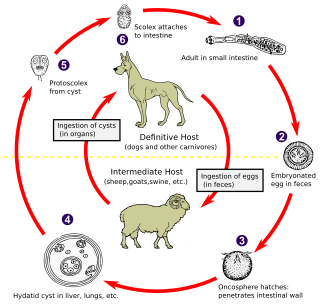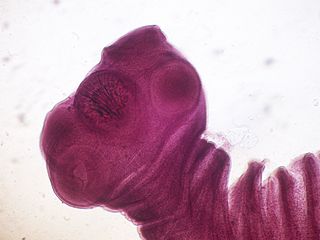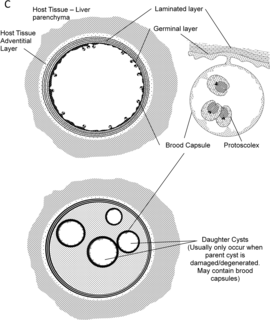
Echinococcosis is a parasitic disease of tapeworms of the Echinococcus type. The two main types of the disease are cystic echinococcosis and alveolar echinococcosis. Less common forms include polycystic echinococcosis and unicystic echinococcosis.

Taenia solium, the pork tapeworm, belongs to the cyclophyllid cestode family Taeniidae. It is found throughout the world and is most common in countries where pork is eaten. It is a tapeworm which has humans as its definitive host and pigs as the intermediate or secondary hosts. It is transmitted to pigs through human faeces that contain the parasite eggs and contaminate their fodder. Pigs ingest the eggs, which develop into larvae, then into oncospheres, and ultimately into infective tapeworm cysts, called cysticercus. Humans acquire the cysts through consumption of uncooked or under-cooked pork and the cysts grow into an adult worms in the small intestine.

Taenia is the type genus of the Taeniidae family of tapeworms. It includes some important parasites of livestock. Members of the genus are responsible for taeniasis and cysticercosis in humans, which are types of helminthiasis belonging to the group of neglected tropical diseases. More than 100 species are recorded. They are morphologically characterized by a ribbon-like body composed of a series of segments called proglottids; hence the name Taenia. The anterior end of the body is the scolex. Some members of the genus Taenia have an armed scolex ; of the two major human parasites, Taenia saginata has an unarmed scolex, while Taenia solium has an armed scolex.

Taenia saginata, commonly known as the beef tapeworm, is a zoonotic tapeworm belonging to the order Cyclophyllidea and genus Taenia. It is an intestinal parasite in humans causing taeniasis and cysticercosis in cattle. Cattle are the intermediate hosts, where larval development occurs, while humans are definitive hosts harbouring the adult worms. It is found globally and most prevalently where cattle are raised and beef is consumed. It is relatively common in Africa, Europe, Southeast Asia, South Asia, and Latin America. Humans are generally infected as a result of eating raw or undercooked beef which contains the infective larvae, called cysticerci. As hermaphrodites, each body segment called proglottid has complete sets of both male and female reproductive systems. Thus, reproduction is by self-fertilisation. From humans, embryonated eggs, called oncospheres, are released with faeces and are transmitted to cattle through contaminated fodder. Oncospheres develop inside muscle, liver, and lungs of cattle into infective cysticerci.

Echinococcus is a genus within cestoda, a parasitic class of the platyhelminthes phylum. Human echinococcosis is an infectious disease caused by the following species: E. granulosus, E. multilocularis, or E. vogeli.

Echinococcus granulosus, also called the hydatid worm, hyper tape-worm or dog tapeworm, is a cyclophyllid cestode that dwells in the small intestine of canids as an adult, but which has important intermediate hosts such as livestock and humans, where it causes cystic echinococcosis, also known as hydatid disease. The adult tapeworm ranges in length from 3 mm to 6 mm and has three proglottids ("segments") when intact—an immature proglottid, mature proglottid and a gravid proglottid. The average number of eggs per gravid proglottid is 823. Like all cyclophyllideans, E. granulosus has four suckers on its scolex ("head"), and E. granulosus also has a rostellum with hooks. Several strains of E. granulosus have been identified, and all but two are noted to be infective in humans.

Echinococcus multilocularis is a small cyclophyllid tapeworm found extensively in the northern hemisphere. E. multilocularis, along with other members of the Echinococcus genus, produce diseases known as echinococcosis. Unlike E. granulosus,E. multilocularis produces many small cysts that spread throughout the internal organs of the infected animal. The resultant disease is called Alveolar echinococcosis, and is caused by ingesting the eggs of E. multilocularis.

Dwarf tapeworm is a cosmopolitan species though most common in temperate zones, and is one of the most common cestodes infecting humans, especially children.
Echinococcus shiquicus is a parasitic worm first identified in 2005. It was found in Tibetan foxes in the Qinghai–Tibet plateau region. Two types of adult worms were recovered and the variant which had a short strobila consisting of single immature and single gravid segments constituted the majority of the specimens. The strobila, rostellar hooks, location of the genital pore and the number of eggs in gravid uterus helped in differentiating Echinococcus shiquicus from the other species. The metacestode of E. shiquicus was detected exclusively from plateau pikas. The larvae are unique and they develop into unilocular minicysts approximately 1 cm in diameter within the liver or lungs.

Taenia pisiformis, commonly called the rabbit tapeworm, is an endoparasitic tapeworm which causes infection in lagomorphs, rodents, and carnivores. Adult T. pisiformis typically occur within the small intestines of the definitive hosts, the carnivores. Lagomorphs, the intermediate hosts, are infected by fecal contamination of grasses and other food sources by the definitive hosts. The larval stage is often referred to as Cysticercus pisiformis and is found on the livers and peritoneal cavities of the intermediate hosts. T. pisiformis can be found worldwide.

Eucestoda, commonly referred to as tapeworms, is the larger of the two subclasses of flatworms in the class Cestoda. Larvae have six posterior hooks on the scolex (head), in contrast to the ten-hooked Cestodaria. All tapeworms are endoparasites of vertebrates, living in the digestive tract or related ducts. Examples are the pork tapeworm with a human definitive host, and pigs as the secondary host, and Moniezia expansa, the definitive hosts of which are ruminants.

Coenurosis is a parasitic infection that results when humans ingest the eggs of dog tapeworm species Taenia multiceps, T. serialis, T. brauni, or T. glomerata.
Taenia asiatica, commonly known as Asian taenia or Asian tapeworm, is a parasitic tapeworm of humans and pigs. It is one of the three species of Taenia infecting humans and causes taeniasis. Discovered only in 1980s from Taiwan and other East Asian countries as an unusual species, it is so notoriously similar to Taenia saginata, the beef tapeworm, that it was for a time regarded as a slightly different strain. But anomaly arose as the tapeworm is not of cattle origin, but of pigs. Morphological details also showed significant variations, such as presence of rostellar hooks, shorter body, and fewer body segments. The scientific name designated was then Asian T. saginata. But the taxonomic consensus turns out to be that it is a unique species. It was in 1993 that two Korean parasitologists, Keeseon S. Eom and Han Jong Rim, provided the biological bases for classifying it into a separate species. The use of mitochondrial genome sequence and molecular phylogeny in the late 2000s established the taxonomic status.

Coenurosis, also known as caenurosis, coenuriasis, gid or sturdy, is a parasitic infection that develops in the intermediate hosts of some tapeworm species. It is caused by the coenurus, the larval stage of these tapeworms. The disease occurs mainly in sheep and other ungulates, but it can also occur in humans by accidental ingestion of tapeworm eggs.

A metacestode is the larval stage of a tapeworm, found in an intermediate host. It can take various forms, for example, the hydatid cyst, strobilocercus, cysticercus or cysticercoid.
Taenia serialis, also known as a canid tapeworm, is found within canines such as foxes and dogs. Adult T. serialis are parasites of carnivores, particularly dogs, with herbivorous lagomorph mammals such as rabbits and hares, serving as intermediate hosts. In definitive hosts, T. serialis is acquired by eating tissues from a variety of intermediate hosts. Accidental infection of humans though, can occur when eggs are ingested from food or water contaminated with dog feces and the human then becomes the T. serialis intermediate host.

Raillietina tetragona is a parasitic tapeworm belonging to the class Cestoda. It is a cosmopolitan helminth of the small intestine of pigeon, chicken and guinea fowl, and is found throughout the world.

Taenia hydatigena is one of the adult forms of the canine and feline tapeworm. This infection has a worldwide geographic distribution. Humans with taeniasis can infect other humans or animal intermediate hosts by eggs and gravid proglottids passed in the feces.
Bertiella mucronata is a species of Bertiella, a type of cestode tapeworms known to cause Bertielliasis. It belongs to the genus Bertiella, family Anoplocephalidae. This is one of two species of Bertiella that can cause the condition in humans.
Flamingolepis liguloides is a parasitic tapeworm of the Cestoda class. There are several tapeworms that are found to infect Artemia; however, F. liguloides is the most prevalent species of infectious tapeworm among Artemia. F. liguloides infects brine shrimp (Artemia) as the intermediate host and flamingos as the definitive host. Effects of the tapeworm in flamingos is unclear, though researchers hypothesize that a high parasitemia could potentially be deadly to the host. The parasite appears to affect the Artemia spp. as it alters the behavior and color of its host.










